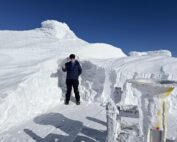Monthly summary
2007-08-16 04:07:00.000 – Ryan Knapp, Meteorologist
NULL
Last month I described how June marked the end of a climatological year on the summits and described a few of the key climatological points that came out of the 2006-2007 weather summary. If you feel confused, lost, or curious as to what I am talking about, go to the observer comments archive and look at Friday, July 20. With August now present on our calendars, that means that monthly summary has been completed for July, the first month of a new year here on the summits. So without further ado, here is how the higher summits are fairing so far.
The average temperature was 48.2 Fahrenheit, a departure of -0.5 from the 30 year normal. This was kind of surprising especially since most parts of the country/world are experiencing the warmest summer on record. The highest temperature during the month was on the 26th at 65 Fahrenheit and the coolest temperature during the month was 30 Fahrenheit on the 1st. There weren’t any daily maximum or minimum temperatures tied or broken during the month. The summits received 7.63 inches of precipitation which is 0.39 inches below the 30 year normal. Although precipitation was below average, the snowfall amount was above normal. The summits received 0.4 inches of snow and hail which is 0.4 inches above the 30 year normal. Not bad for a summer month. The peak wind was 72 mph from the northwest on the 7th with a monthly average of 25.1 mph. This was 0.9 mph below the 30 year normal. The summits only experienced 23 percent of its possible sunshine minutes which means that during the 6469 minutes of sunshine the summits did receive, I was outside absorbing as much radiation as possible so I could go from a pasty white to more of an eggshell tone. Out of the 31 days, 30 of them had fog during at least some portion of the 24 hour period. And there were 23 days with rain and 4 days with snow.
So what conclusions can be drawn from this data? Well nothing too concrete since it is only one month of data. I can’t determine how much snow the winter will bring based on this data. I can’t conclusively state that this was the warmest summer on record. I can’t say that this will be a drought year. I can’t say that we are going to be windier, foggier, colder, snowier, etc. I cannot state anything conclusive from this data, to do so would be like saying “Well based on this past months data, an ice age must be coming since we showed some cooling.” We will have to see what the next eleven months bring before anything too conclusive can be drawn. So stay tuned…
Ryan Knapp, Meteorologist
An Experience Worth 1,000 More
An Experience Worth 1,000 More By Mitchell Tsokatos Me and the summit sign once winter really got going. Taken 11/2/25. Unfortunately, my time on Mount Washington as an intern has come to
Supporter Spotlight: AJ Mastrangelo
Supporter Spotlight: AJ Mastrangelo By Wendy Almeida A young AJ on the summit with Rebecca Scholand. AJ Mastrangelo’s relationship with Mount Washington Observatory began long before his internship—or his current career as
Supporter Spotlight: Angelo Decrisantis
Supporter Spotlight: Angelo Decrisantis By Wendy Almeida For Angelo Decrisantis, Mount Washington has been a lifelong connection. It began in 1965, at age 15, on a family drive to the summit. “My first experience



